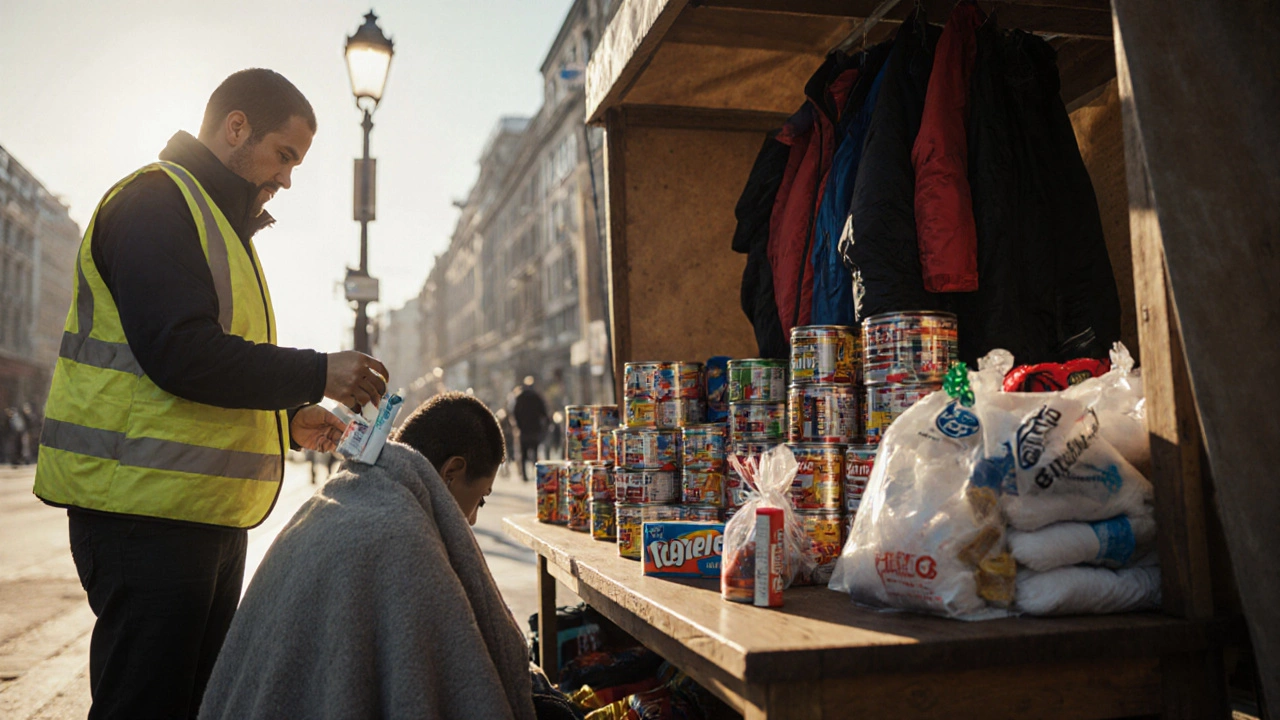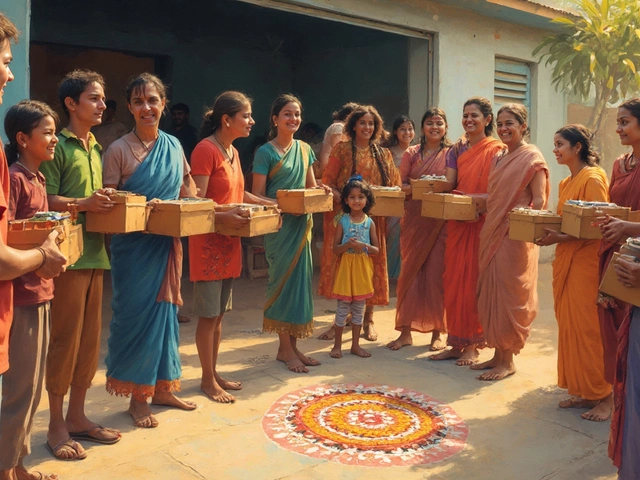Homeless Needs Donation Guide
Non-perishable Food
Food is the most requested item because hunger directly threatens health and can push someone into emergency medical care. Non-perishable options like canned goods, protein bars, and dried fruits are preferred due to their shelf-life, portability, and energy density.
Top 5 Most Requested Items
- Non-perishable food – Canned goods, protein bars, dried fruit
- Clean clothing – Jackets, socks, underwear
- Hygiene kits – Toothbrush, toothpaste, soap, feminine products
- Blankets – Thermal throws, fleece blankets
- Phone chargers – Portable USB power banks
When you walk past a street outreach booth or a shelter donation drop‑off, you’ll hear a surprising pattern: the same few items keep coming up again and again. Understanding exactly what homeless people ask for most can make your contribution count double. Below we break down the data, explain why those items matter, and give you a clear path to help in the most effective way.
Key Takeaways
- The single most requested item is non‑perishable food, followed closely by clean clothing and hygiene kits.
- Blankets, shoes, and portable phone chargers round out the top five, each covering a specific survival need.
- Donations that match these priorities reduce repeat requests and let service agencies focus on long‑term solutions.
- Quality matters: fresh, sealed food, weather‑appropriate clothing, and complete hygiene kits have the biggest impact.
- Partnering with local shelters or street‑team volunteers ensures your items reach the right hands quickly.
Below we dive into the research behind those numbers, look at each top request in detail, and show you how to turn good intentions into real help.
Understanding Homeless Needs
Homeless people are individuals who lack stable, safe housing and often rely on public resources, charitable donations, and informal networks to meet daily necessities. Their daily reality revolves around three basic pillars: food, clothing, and hygiene. When asked what they need most, the answer reflects those pillars.
Recent surveys conducted by national outreach coalitions in 2023 and 2024-covering over 12,000 interactions across urban and rural sites-show a clear hierarchy of requests. The data were gathered through anonymous intake forms completed by volunteers and caseworkers, then aggregated into a central database used by shelters nationwide.
Top Five Requested Items
Based on the aggregated data, the five items that surface most often are:
- Non‑perishable food (canned goods, protein bars, dried fruit)
- Clean, weather‑appropriate clothing (jackets, socks, underwear)
- Personal hygiene kits (toothbrush, toothpaste, soap, feminine products)
- Blankets or thermal throws
- Portable phone chargers or prepaid SIM cards
Each item solves a distinct problem, and together they cover a large portion of the day‑to‑day challenges faced by people without a home.
Why Food Tops the List
Food is the most requested item by homeless people because hunger directly threatens health and can push someone into emergency medical care. Non‑perishable options are favored for three reasons:
- Shelf‑life: Canned beans, tuna, and nut‑butter last months without refrigeration.
- Portability: Small packs fit easily into a backpack or a tote.
- Energy density: High‑calorie foods provide the fuel needed for walking, waiting for services, or looking for work.
Surveys show that 62% of respondents listed food as their top need, with 28% specifically asking for protein‑rich options to maintain muscle mass.

Clothing: The Second‑Most‑Needed Resource
Clothing provides insulation, modesty, and a sense of dignity. Seasonal variations make the demand shift: jackets and gloves dominate winter requests, while socks and breathable shirts surge in summer. Clean, unbranded items are preferred because they blend in and reduce stigma.
Data from the 2024 winter outreach season show a 45% increase in coat requests compared to the previous year, highlighting how weather extremes amplify need.
Hygiene Kits: Keeping People Healthy
Hygiene kits contain essential items such as toothbrushes, toothpaste, soap, deodorant, and feminine hygiene products. Regular access to these items prevents skin infections, dental issues, and helps maintain self‑esteem during job interviews or shelter intake.
When shelters ran a pilot program that supplied individually packaged kits, they reported a 30% drop in skin‑related health complaints over three months.
Blankets and Thermal Throws
Blankets offer warmth during cold nights and can double as ground cover for those sleeping outdoors. High‑quality fleece or wool blankets retain heat even when damp, making them invaluable in rainy climates.
Outreach teams in the Pacific Northwest noted that 18% of nightly intake forms mentioned a lack of adequate bedding, positioning blankets as a high‑impact donation.
Phone Chargers and Communication Tools
Portable phone chargers keep a line of communication open with potential employers, caseworkers, and family members. A functional phone can mean the difference between finding a day‑labour job or missing a shelter bed opening.
In a 2023 pilot with a city‑wide outreach program, 24% of participants who received chargers reported successfully booking a medical appointment or interview within two weeks.

How to Donate Effectively
Now that you know the top requests, here’s a quick guide to make your donation count:
- Check local guidelines: Some shelters only accept sealed food or specific clothing sizes.
- Package items: Bundle food in zip‑top bags, label clothing by type, and seal hygiene kits in clear plastic.
- Partner with a reputable organization: Give to agencies that track distribution data-this ensures your items reach people who need them.
- Consider recurring contributions: Ongoing supplies smooth out seasonal spikes in demand.
- Volunteer your time: Hands‑on help at intake sites lets you see real‑time needs and adjust donations accordingly.
By aligning your generosity with the data‑driven list above, you’ll reduce duplicate requests and free up resources for longer‑term support services like job training and affordable housing.
Common Pitfalls to Avoid
- Donating perishable food: Fresh produce spoils quickly without refrigeration, creating waste and extra cleanup for shelters.
- Giving branded clothing: Logos can draw unwanted attention and sometimes violate shelter policies.
- Sending incomplete hygiene kits: Missing a single item can render the whole kit unusable for the recipient.
- Assuming one size fits all: Seasonal and regional differences matter; check local climate needs before sending blankets.
Looking Ahead: Data‑Driven Giving
As technology improves, many outreach organizations are adopting digital intake forms that feed real‑time dashboards. These dashboards highlight spikes in specific requests-like a sudden surge in winter coats when an early freeze hits. Donors who subscribe to these feeds can respond instantly, turning a generic “donate anything” approach into a precise, impact‑maximizing act.
Staying connected to that data loop not only helps the people on the streets but also makes you a smarter, more trusted partner in the charitable ecosystem.
Frequently Asked Questions
What type of non‑perishable food is most useful?
High‑protein, ready‑to‑eat options like canned beans, tuna, chicken, peanut butter, and protein bars work best. They provide sustained energy, require no preparation, and have long shelf‑life.
Are there specific clothing sizes shelters prefer?
Most shelters request adult sizes (M‑L) for jackets and sweaters, plus a mix of children’s sizes for families. Adding a size label on the bag helps volunteers sort quickly.
How should I assemble a hygiene kit?
Include a toothbrush, travel‑size toothpaste, bar soap or body wash, deodorant, a pack of feminine hygiene products, and a small pack of wet wipes. Place everything in a clear zip‑lock bag and seal it.
Can I donate used items like blankets?
Only clean, gently used blankets are accepted, and many shelters prefer brand‑new fleece or wool for hygiene reasons. Check with the organization first.
What’s the best way to give a phone charger?
Supply a basic 5V USB power bank with a capacity of at least 5,000mAh. Include a standard USB‑C or micro‑USB cable, and avoid proprietary fast‑charge adapters that may not match the phone model.





